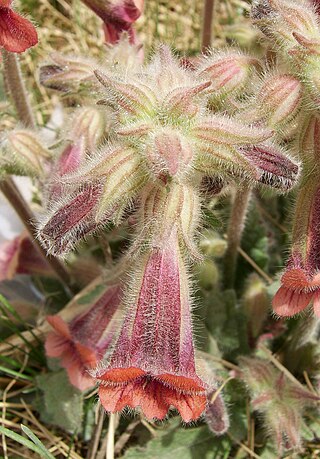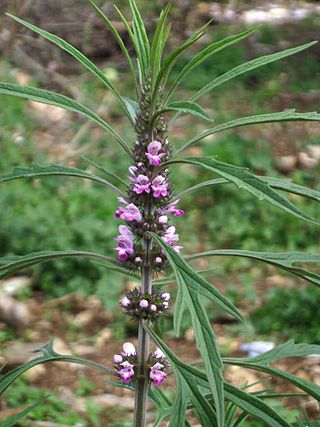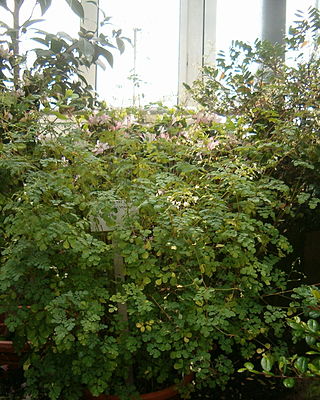
Chives, scientific name Allium schoenoprasum, is a species of flowering plant in the family Amaryllidaceae that produces edible leaves and flowers. Their close relatives include the common onions, garlic, shallot, leek, scallion, and Chinese onion.

Spearmint, a species of mint (mentha) scientifically classified as Mentha spicata (,) also known as garden mint, common mint, lamb mint and mackerel mint, is native to Europe and southern temperate Asia, extending from Ireland in the west to southern China in the east. It is naturalized in many other temperate parts of the world, including northern and southern Africa, North America, and South America. It is used as a flavouring in food and herbal teas. The aromatic oil, called oil of spearmint, is also used as a flavoring and sometimes as a scent.

The Piperaceae, also known as the pepper family, are a large family of flowering plants. The group contains roughly 3,600 currently accepted species in 5 genera. The vast majority of species can be found within the two main genera: Piper and Peperomia.

Hypericum is a genus of flowering plants in the family Hypericaceae. The genus has a nearly worldwide distribution, missing only from tropical lowlands, deserts and polar regions. Many Hypericum species are regarded as invasive species and noxious weeds. All members of the genus may be referred to as St. John's wort, and some are known as goatweed. The white or pink flowered marsh St. John's worts of North America and eastern Asia are generally accepted as belonging to the separate genus TriadenumRaf.

Dysphania ambrosioides, formerly Chenopodium ambrosioides, known as Jesuit's tea, Mexican-tea, payqu(paico), epazote, mastruz, or herba sanctæ Mariæ, is an annual or short-lived perennial herb native to Central America, South America, and southern Mexico.

Rehmannia is a genus of seven species of flowering plants in the order Lamiales and family Orobanchaceae, endemic to China. It has been placed as the only member of the monotypic tribe Rehmannieae, but molecular phylogenetic studies suggest that it forms a clade with Triaenophora. Contrary to the immense majority of the taxa of Orobanchaceae, Rehmannia is not parasitic.

Triadenum, known as marsh St. John's worts, is a small genus of flowering plants in the family Hypericaceae. The genus is characterized by opposite, blunt-tipped leaves and pink flowers with 9 stamens. They are distributed in North America and eastern Asia.

Pandanaceae is a family of flowering plants native to the tropics and subtropics of the Old World, from West Africa through the Pacific. It contains 982 known species in five genera, of which the type genus, Pandanus, is the most important, with species like Pandanus amaryllifolius and karuka being important sources of food. The family likely originated during the Late Cretaceous.

Cardamine hirsuta, commonly called hairy bittercress, is an annual or biennial species of plant in the family Brassicaceae, and is edible as a salad green. It is common in moist areas around the world.

Mollugo verticillata, the green carpetweed, is a rapidly spreading annual plant from tropical America. In eastern North America, it is a common weed growing in disturbed areas. It forms a prostrate circular mat that can quickly climb over nearby plants and obstacles. The species has been reported from every state in the United States except Alaska, Hawaii, and Utah, as well as from British Columbia, Manitoba. Ontario, Quebec, New Brunswick and Nova Scotia. Although considered an invasive weed, M.verticillata is also known to be edible. Archaeological evidence has shown that M. verticillata has been in North America for about 3000 years. Sometimes also referred to as "Indian chickweed", in China this plant is referred to as zhong leng su mi cao.

Ephedra sinica is a species of Ephedra native to Mongolia, Russia, and northeastern China.

Leonurus sibiricus, commonly called honeyweed or Siberian motherwort, is an herbaceous plant species native to China, Mongolia, and Siberia. It has verticillaster inflorescence. It is naturalized in many other parts of the world, including South, Central and North Americas.

Alisma lanceolatum is a species of aquatic plant in the water plantain family known by the common names lanceleaf water plantain and narrow-leaved water plantain. It is widespread across Europe, North Africa and temperate Asia. It is naturalized in Australia, New Zealand, Oregon, California and British Columbia. It is considered a noxious weed in some places.

Boenninghausenia is a monotypic plant genus in the family Rutaceae. The sole species is Boenninghausenia albiflora, which occurs in Bhutan, Nepal, Pakistan, Kashmir, India, Indonesia, Philippines, Myanmar, Thailand, Laos, North Vietnam, China and Japan.

Najas marina is a species of aquatic plant known by the common names spiny water nymph, spiny naiad and holly-leaved naiad. It is an extremely widespread species, reported across Europe, Asia, Africa, Australia, the Americas and many oceanic islands. It can be found in many types of freshwater and brackish aquatic habitat, including bodies of alkaline water.

Saccharum sinense or Saccharum × sinense, synonym Saccharum × barberi, sugarcane, is strong-growing species of grass (Poaceae) in the genus Saccharum. It is originally cultivated in Guangzhou, China where it is still commonly grown. It is a more primitive form of sugarcane with a hybrid origin from Saccharum officinarum and Saccharum spontaneum species of cane. A number of clones exists that are often included in the S. officinarum species as the Pansahi group. The most notable member of which is the Uba variety of cane. They are a perennial plant that grows in erect clumps that can reach up to 5 meters in height and have a red cane with a diameter of 15 mm to 30 mm.

Hypericum lancasteri, known as Lancaster's St. John's wort or as zhan e jin si tao in Chinese, is a species of flowering plant in the St. John's wort family Hypericaceae. The species has been awarded the Royal Horticultural Society's Award of Garden Merit.

Horaninovia is a genus of flowering plants belonging to the family Amaranthaceae. It also belongs to the tribe Salsoleae as well as in the subfamily Salsoloideae.

Hypecoum erectum is a species of annual herb in the poppy family native to China, Mongolia, and Russia. In China, the plant is commonly called 角茴香.



















